A Marble Bust Newly Discovered by the Trapani Lombardo Family of Reggio Calabria (Southern Italy)
Abstract
1. Introduction and Stylistic, Iconographic Analysis of the Bust
2. State of Conservation of the Bust
3. Sampling and Analytical Methods
4. Results and Discussion
4.1. Mineralogical–Petrographic and Geochemical Characterization of the Bust
Polarizing Optical Microscopy, X-ray Diffraction, and Isotopic Analysis
4.2. Molecular and Geochemical Characterization of the Alteration Products
FT-IR, X-ray Diffraction, and SEM-EDX Analysis
- -
- the presence of gypsum with characteristic peaks at about 3500, 3400, 1700, 1600, 1150, 1100, 700, and 600 cm−1 for sample BF_tl_2;
- -
- the stretching vibrations of aragonite (i.e., a polymorph of calcium carbonate) peaked at 1446, 854, 712, and 700 cm−1 [64] for sample BF_tl_3, followed by calcite, quartz, traces of gypsum, and hematite (iron oxide);
- -
- the stretching vibrations of calcite peaked at 1492–1429, 879, and 706 cm−1, with the presence of hematite with peaks at about 560–550, 474–467, and 310 cm−1 for samples BF_tl_4 and BF_tl_5. In addition, gypsum was detected in BF_tl_4.
5. Conclusions
Author Contributions
Funding
Institutional Review Board Statement
Informed Consent Statement
Data Availability Statement
Conflicts of Interest
References
- Antonelli, F.; Nestola, F. An innovative approach for provenancing ancient white marbles: The contribution of x-ray diffraction to disentangling the origins of Göktepe and Carrara marbles. Sci. Rep. 2021, 11, 22312. [Google Scholar] [CrossRef] [PubMed]
- Antonelli, F.; Lazzarini, L. The use of white marble in the Central and Upper Adriatic between Greece and Rome: A case study of the Hellenistic stelae from the necropolis in Ancona (Marche, Italy). Camb. Archaeol. J. 2013, 23, 149–162. [Google Scholar] [CrossRef]
- Belfiore, C.M.; Ricca, M.; La Russa, M.F.; Ruffolo, S.A.; Galli, G.; Barca, D.; Malagodi, M.; Vallefuoco, M.; Sprovieri, M.; Pezzino, A. Provenance study of building and statuary marbles from the Roman archaeological site of “Villa dei Quintili” (Rome, Italy). Ital. J. Geosci. 2016, 135, 236–249. [Google Scholar] [CrossRef]
- Wielgosz-Rondolino, D.; Antonelli, F.; Bojanowski, M.J.; Gładki, M.; Göncüoğlu, M.C.; Lazzarini, L. Improved methodology for identifcation of Göktepe white marble and the understanding of its use: A comparison with Carrara marble. J. Archaeol. Sci. 2020, 113, 105059. [Google Scholar] [CrossRef]
- Orsi, P. Reggio Calabria. Scoperte negli anni dal 1911 al 1921. In Notizie degli Scavi di Antichità. Atti Dell’accademia Nazionale dei Lincei; Accademia Nazionale dei Lincei: Roma, Italy, 1922; pp. 151–186. [Google Scholar]
- Baker, M.; Harrison, C.; Laing, A. Bouchardon’s British Sitters: Sculptural Portraiture in Rome and the Classicising Bust around 1730. Burlingt. Mag. 2000, 142, 752–762. Available online: http://www.jstor.org/stable/888973 (accessed on 1 May 2023).
- Malacrino, C. Il balneum di palazzo Oliva a Reggio Calabria. In Tra Ionio e Tirreno: Orizzonti d’archeologia. Omaggio a Elena Lattanzi; Spadea, R., Lo Schiavo, F., Lazzarini, M.L., Eds.; Scienze e Lettere: Roma, Italy, 2020; pp. 267–285. [Google Scholar]
- Buccilo, L. Le domus a Roma nel III secolo d.C.: Proprietà, distribuzione topografica e arredi di lusso. In L’età Dell’angoscia. Da Commodo a Diocleziano; La Rocca, E., Parisi Presicce, C., Lomonaco, A., Eds.; Mondo Mostre: Roma, Italy, 2016; pp. 116–126. [Google Scholar]
- Buccino, L. Sculture esibite e sculture ritrovate a Piazza Colonna. In La Galleria di Piazza Colonna; La Rocca, E., Olmo, C., Eds.; Umberto Allemandi & C.—Sorgente Group: Roma, Italy, 2011; pp. 213–228. ISBN 978-88-422-2018-3. [Google Scholar]
- Riccomini, A.M. La Scultura; Editore Carocci: Roma, Italy, 2014; EAN: 9788843071180. [Google Scholar]
- Rowan, C. The public image of the Severan Women. Pap. Br. Sch. Rome 2011, 79, 241–273. [Google Scholar] [CrossRef]
- Bartman, E. Hair and artifice of Roman female adornment. Am. J. Archaeol. 2001, 105, 1–25. [Google Scholar] [CrossRef]
- Buccino, L. Morbidi capelli e acconciature sempre diverse. Linee evolutive delle pettinature femminili nei ritratti scultorei dal secondo triumvirato all’età costantiniana. In Ritratti. Le Tante Facce del Potere; La Rocca, E., Parisi Presicce, C., Eds.; MondoMostre: Roma, Italy, 2011; pp. 360–383. ISBN 978-88-905853-5-7. [Google Scholar]
- Riccomini, A.M. Contributi alla ritrattistica di età severiana dalla collezione Gonzaga. Prospettiva 2014, 153, 128–135. [Google Scholar]
- Caneva, G.; Nugari, M.P.; Salvadori, O. Plant Biology for Cultural Heritage; The Getty Conservation Institute: Los Angeles, CA, USA, 2008. [Google Scholar]
- Warscheid, T. The evaluation of biodeterioration processes on cultural objects and approaches for their effective control. In Art, Biology, and Conservation: Biodeterioration of Works of Art; Koestler, R.J., Koestler, V.H., Charola, A.E., Nieto-Fernandez, F.E., Eds.; Metropolitan Museum of Art: New York, NY, USA, 2003; pp. 14–27. [Google Scholar]
- Urzì, C. Microbial deterioration of rocks and marble monuments in the Mediterranean basin: A review. Corros. Rev. 2004, 22, 441–457. [Google Scholar] [CrossRef]
- Nimis, P.L.; Lazzarin, G.; Gasparo, D. Lichens as bioindicators of air pollution by SO2 in the Veneto Region (ne Italy). Stud. Geobot. 1991, 11, 3–76. Available online: http://hdl.handle.net/10077/15174 (accessed on 2 May 2023).
- Chen, X.; Bai, F.; Huang, J.; Yongsheng, L.; Yuhuan, W.; Juan, Y.; Shuang, B. The Organisms on Rock Cultural Heritages: Growth and Weathering. Geoheritage 2021, 13, 56. [Google Scholar] [CrossRef]
- Weber, B.; Scherr, C.; Bicker, F.; Friedl, T.; Budel, B. Respiration-induced weathering patterns of two endolithically growing lichens. Geobiology 2011, 9, 34–43. [Google Scholar] [CrossRef] [PubMed]
- Piñar, G.; Garcia-Valles, M.; Gimeno-Torrente, D.; Fernandez-Turiel, J.L.; Ettenauer, J.; Sterflinger, K. Microscopic, chemical, and molecular-biological investigation of the decayed medieval stained window glasses of two Catalonian churches. Int. Biodeterior. Biodegrad. 2013, 84, 388–400. [Google Scholar] [CrossRef]
- Sterflinger, K.; Piñar, G. Microbial deterioration of cultural heritage and works of art-tilting at windmills? Appl. Microbiol. Biotechnol. 2013, 97, 9637–9646. [Google Scholar] [CrossRef] [PubMed]
- Graue, B.; Siegesmund, S.; Middendorf, B. Quality assessment of replacement stones for the Cologne Cathedral: Mineralogical and petro-physical requirements. Environ. Earth Sci. 2011, 63, 1799–1822. [Google Scholar] [CrossRef]
- Dick, J.; De Windt, W.; De Graef, B.; Saveyn, H.; Van der Meeren, P.; De Belie, N.; Verstraete, W. Bio-deposition of a calcium carbonate layer on degraded limestone by Bacillus species. Biodegrade 2006, 17, 357–367. [Google Scholar] [CrossRef]
- Jroundi, F.; Fernandez-Vivas, A.; Rodriguez-Navarro, C.; Bedmar, E.J.; Gonzalez-Munoz, M.T. Bioconservation of deteriorated monumental cal-carenite stone and identification of bacteria with carbonatogenic activity. Microb. Ecol. 2010, 60, 39–54. [Google Scholar] [CrossRef]
- Spötl, C.; Vennemann, T.W. Continuous-flow isotope ratio mass spectrometric analysis of carbonate minerals. Rapid Commun. Mass. Spectrom. 2003, 17, 1004–1006. [Google Scholar] [CrossRef]
- Vahur, S.; Teearu, A.; Peets, P.; Joosu, L.; Leito, I. ATR-FT-IR spectral collection of conservation materials in the extended region of 4000-80 cm⁻¹. Anal. Bioanal. Chem. 2016, 408, 3373–3379. [Google Scholar] [CrossRef]
- Derrick, M.R.; Stulik, D.C.; Landry, J.M. Infrared Spectroscopy in Conservation Science; The Getty Conservation Institute: Los Angeles, CA, USA, 1999. [Google Scholar]
- Lazzarini, L.; Moschini, G.; Stievano, B.M. A contribution to the identification of Italian, Greek and Anatolian marbles through a petrographical study and the evaluation of Ca/Sr ratio. Archaeom 1980, 22, 173–183. [Google Scholar] [CrossRef]
- Moens, L.; Roos, P.; De Rudder, J.; De Paepe, P.; Van Hende, J.; Waelkens, M. A multi-method approach to the identification of white marbles used in antique artifacts. In Classical Marble: Geochemistry, Technology, Trade; Herz, N., Waelkens, M., Eds.; Springer: Dordrecht, The Netherlands, 1988; Volume 153, pp. 243–250. [Google Scholar]
- Lapuente Mercadal, M.P.; Nogales-Basarrate, T.; Carvalho, A. Mineralogical Insights to Identify Göktepe Marble in the Sculptural Program of Quinta Das Longas Villa (Lusitania). Minerals 2021, 11, 1194. [Google Scholar] [CrossRef]
- Gorgoni, C.; Lazzarini, L.; Pallante, P.; Turi, B. An updated and detailed mineropetrographic and C-O stable isotopic reference database for the main Mediterranean marbles used in antiquity. In Proceedings of the Fifth International Conference of the Association for the Study of Marble and Other Stones in Antiquity, Boston, MA, USA, 8–12 June 1998; Herrmann, J.J., Herz, N., Newman, R., Eds.; Museum of Fine Arts: London, UK, 2002; pp. 1–25. [Google Scholar]
- Lazzarini, L. Pietre e Marmi Antichi. Natura, Caratterizzazione, Origine, Storia D’uso, Diffusione, Collezionismo; CEDAM: Padova, Italy, 2004. [Google Scholar]
- Attanasio, D.; Brilli, M.; Ogle, N. The Isotopic Signature of Classical Marbles; L’Erma di Bretschneider: Roma, Italy, 2006. [Google Scholar]
- Origlia, F.; Gliozzo, E.; Meccheri, M.; Spangenberg, J.E.; Turbanti Memmi, I.; Papi, E. Mineralogical, petrographic and geochemical characterization of white and coloured Iberian marbles in the context of the provenancing of some artefacts from Thamusida (Kenitra, Morocco). Eur. J. Mineral. 2011, 23, 857–869. [Google Scholar] [CrossRef]
- Taelman, D.; Elburg, M.; Smet, I.; De Paepe, P.; Vanhaecke, F.; Vermeulen, F. White veined marble from Roman Ammaia (Portugal): Provenance and use. Archaeom 2013, 55, 370–390. [Google Scholar] [CrossRef]
- Brilli, M.; Lapuente Mercadal, M.P.; Giustini, F.; Plumed, H.R. Petrography and mineralogy of the white marble and black stone of Göktepe (Muğla, Turkey) used in antiquity: New data for provenance determination. J. Archaeol. Sci. Rep. 2018, 19, 625–642. [Google Scholar] [CrossRef]
- Attanasio, D.; Bruno, M.; Prochaska, W.; Yavuz, A.B. Revaluation of the marble provenance of the Esquiline Group Sculptures (Ny Carlsberg Glyptotek, Copenhagen). Following the discovery of the Aphrodisian marble quarries at Göktepe. Mitt. Dtsch. Archaol. Inst.—Rom. Abt. 2015, 121, 567–589. [Google Scholar]
- Poretti, G.; Brilli, M.; De Vito, C.; Conte, A.M.; Borghi, A.; Günther, D.; Zanetti, A. New considerations on trace elements for quarry provenance investigation of ancient white marbles. J. Cult. Herit. 2017, 28, 16–26. [Google Scholar] [CrossRef]
- Prochaska, W.; Attanasio, D.; Bruno, M. Unravelling the Carrara—Göktepe entanglement. In ASMOSIA XI. Interdisciplinary Studies of Ancient Stone, Proceedings of the Eleventh International Conference of ASMOSIA, Split, Croatia, 18–22 May 2015; Matetić Poljak, D., Marasović, K., Eds.; Matetić Poljak, D., Marasović, K., Eds.; University of Split: Split, Croatia, 2015; pp. 175–183. [Google Scholar] [CrossRef]
- Antonelli, F.; Lazzarini, L. An updated petrographic and isotopic reference database for white marbles used in Antiquity. Rend. Fis. Acc. Lincei 2015, 26, 399–413. [Google Scholar] [CrossRef]
- Lapuente, P.; Turi, B.; Blanc, P. Marbles from Roman Hispania: Stable isotope and cathodoluminescence characterization. Appl. Geoch. 2000, 15, 1469–1493. [Google Scholar] [CrossRef]
- Ricca, M.; La Russa, M.F.; Ruffolo, S.A.; Davidde, B.; Barca, D.; Crisci, G.M. Mosaic marble tesserae from the underwater archaeological site of Baia (Naples, Italy): Determination of the provenance. Eur. J. Mineral. 2014, 26, 323–331. [Google Scholar] [CrossRef]
- Craig, H.; Craig, V. Greek marbles: Determination of provenance by isotopic analysis. Science 1972, 176, 401–403. [Google Scholar] [CrossRef]
- Attanasio, D.; Brilli, M.; Bruno, M. The properties and identification of marble from Proconnesos (Marmara Island, Turkey): A new database including isotopic, EPR and petrographic data. Archaeom 2008, 50, 747–774. [Google Scholar] [CrossRef]
- Attanasio, D.; Bruno, M.; Prochaska, W.; Yavuz, A.B. A multi-method database of the black and white Marbles of Göktepe (Aph-rodisias), including Isotopic, EPR, trace and petrographic data. Archaeom 2015, 57, 217–245. [Google Scholar] [CrossRef]
- Capedri, S.; Venturelli, G. Accessory minerals as tracers in the provenancing of archaeological marbles, used in combination with isotopic and petrographic data. Archaeom 2004, 46, 517–536. [Google Scholar] [CrossRef]
- Capedri, S.; Venturelli, G.; Photiades, A. Accessory minerals and δ18O and δ13C of marbles from the Mediterranean area. J. Cult. Herit. 2004, 5, 27–47. [Google Scholar] [CrossRef]
- Gorgoni, C.; Lazzarini, L.; Pallante, P. Identification of ancient white marbles in Rome. I: The Arch of Titus. Sci. Technol. Cult. Herit. 1992, 1, 79–86. [Google Scholar]
- Herz, N.; Dean, N.E. Stable isotopes and archaeological geology: The Carrara marble, northern Italy. Appl. Geochem. 1986, 1, 139–151. [Google Scholar] [CrossRef]
- Herz, N. Provenance determination of Neolithic to classical Mediterranean marbles by stable isotopes. Archaeom 1992, 34, 185–194. [Google Scholar] [CrossRef]
- La Russa, M.F.; Ruffolo, S.A.; Ricca, M.; Ricci, S.; Davidde, B.; Barca, D.; Capristo, V. A multidisciplinary approach to the study of underwater artefacts: The case of a Tritone Barbato marble statue (Grotta Azzurra, Island of Capri, Naples). Per. Mineral. 2013, 82, 101–111. [Google Scholar] [CrossRef]
- Pensabene, P.; Antonelli, F.; Lazzarini, L.; Cancelliere, S. Provenance of marble sculptures and artifacts from the so-called Canopus and other buildings of “Villa Adriana” (Hadrian’s villa e Tivoli, Italy). J. Archaeol. Sci. 2012, 39, 1331–1337. [Google Scholar] [CrossRef]
- Ricca, M.; Belfiore, C.M.; Ruffolo, S.A.; Barca, D.; Alvarez de Buergo, M.; Crisci, G.M.; La Russa, M.F. Multi-analytical approach applied to the provenance study of marbles used as covering slabs in the archaeological submerged site of Baia (Naples, Italy): The Case of the “Villa con ingresso a protiro”. Appl. Surf. Sci. 2015, 357, 1369–1379. [Google Scholar] [CrossRef]
- La Russa, M.F.; Ricca, M.; Cerioni, A.M.; Chilosi, M.G.; Comite, V.; De Santis, M.; Rovella, N.; Ruffolo, S.A. The colors of the Fontana di Trevi: An analytical approach. Int. J. Archit. Herit. 2018, 12, 114–124. [Google Scholar] [CrossRef]
- Alberghina, M.F.; Casanova Municchia, A.; Germinario, G.; Macchia, A.; Matteini, M.; Milazzo, G.; Ruffolo, S.; Sabbatini, L.; Schiavone, S.; Sodo, A.; et al. A multi-analitycal approach to adress a sustanaible conservation of the main marble portal of the Monreale Cathedral. Int. J. Conserv. Sci. 2020, 11, 353–360. [Google Scholar]
- Randazzo, L.; Collina, M.; Ricca, M.; Barbieri, L.; Bruno, F.; Arcudi, A.; La Russa, M.F. Damage Indices and Photogrammetry for Decay Assessment of Stone-Built Cultural Heritage: The Case Study of the San Domenico Church Main Entrance Portal (South Calabria, Italy). Sustainability 2020, 12, 5198. [Google Scholar] [CrossRef]
- Ricca, M.; Urzì, C.E.; Rovella, N.; Sardella, A.; Bonazza, A.; Ruffolo, S.A.; De Leo, F.; Randazzo, L.; Arcudi, A.; La Russa, M.F. Multidisciplinary Approach to Characterize Archaeological Materials and Status of Conservation of the Roman Thermae of Reggio Calabria Site (Calabria, South Italy). Appl. Sci. 2020, 10, 5106. [Google Scholar] [CrossRef]
- Ricca, M.; Alberghina, M.F.; Randazzo, L.; Schiavone, S.; Donato, A.; Albanese, M.P.; La Russa, M.F. A Combined Non-Destructive and Micro-Destructive Approach to Solving the Forensic Problems in the Field of Cultural Heritage: Two Case Studies. Appl. Sci. 2021, 11, 6951. [Google Scholar] [CrossRef]
- Donato, A.; Randazzo, L.; Ricca, M.; Rovella, N.; Collina, M.; Ruggieri, N.; Dodaro, F.; Costanzo, A.; Alberghina, M.F.; Schiavone, S.; et al. Decay Assessment of Stone-Built Cultural Heritage: The Case Study of the Cosenza Cathedral Façade (South Calabria, Italy). Remote Sens. 2021, 13, 3925. [Google Scholar] [CrossRef]
- Cámara, B.; Álvarez de Buergo, M.; Bethencourt, M.; Fernández-Montblanc, T.; La Russa, M.F.; Ricca, M.; Fort, R. Biodeterioration of marble in an underwater environment. Sci. Total Environ. 2017, 609, 109–122. [Google Scholar] [CrossRef]
- Pensabene, P. Cave di marmo bianco e pavonazzetto in Frigia. Sulla produzione e sui dati epigrafici. Marmora Int. J. Archaeom. Marbl. Stone 2010, 6, 71–134. [Google Scholar]
- Moens, L.; De Paepe, P.; Waelkens, M. Multidisciplinary research and cooperation: Keys to a successful provenance determination of white marble. In Ancient Stones: Quarrying, Trade and Provenance, Acta Archaeologica Lovaniensia Monographie; Waelkens, M., Herz, N., Moens, L., Eds.; Leuven University Press: Leuven, Belgium, 1992; Volume 4, pp. 247–254. [Google Scholar]
- Linga Raju, C.; Narasimhulu, K.; Gopal, N.O.; Rao, J.L.; Reddy, B.C.V. Electron paramagnetic resonance, optical and infrared spectral studies on the marine mussel Arca burnesi shells. J. Mol. Struct. 2002, 608, 201–211. [Google Scholar] [CrossRef]
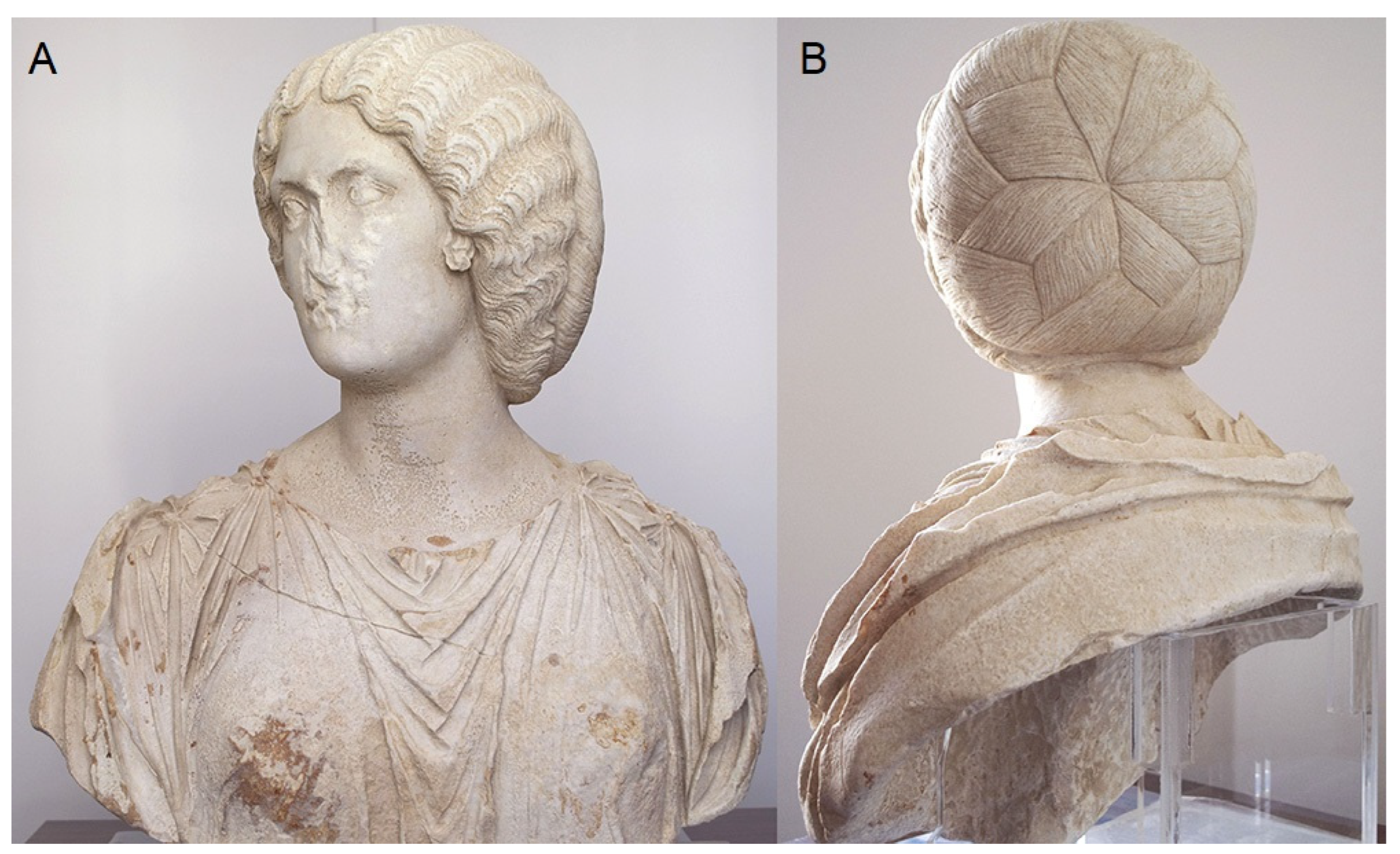
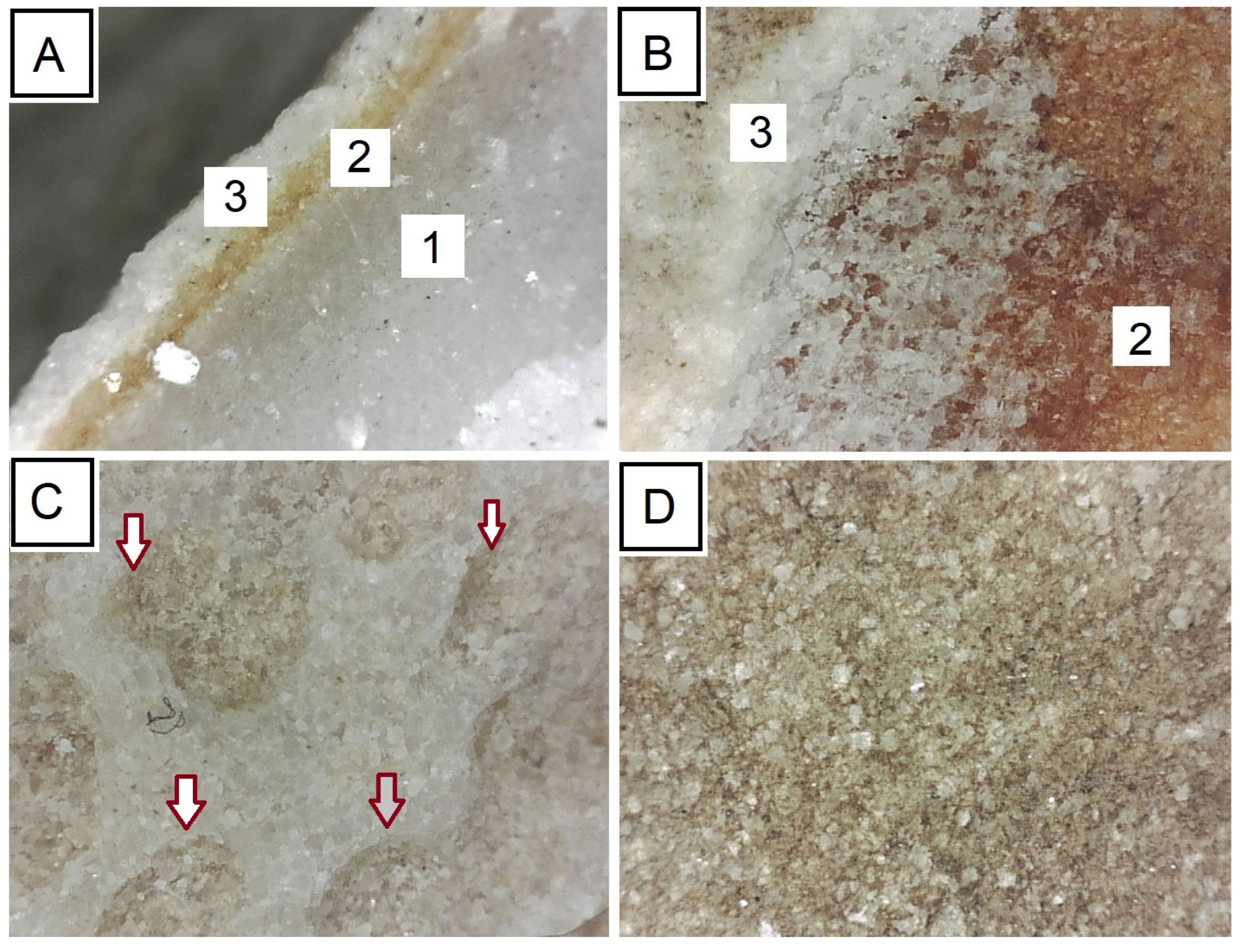
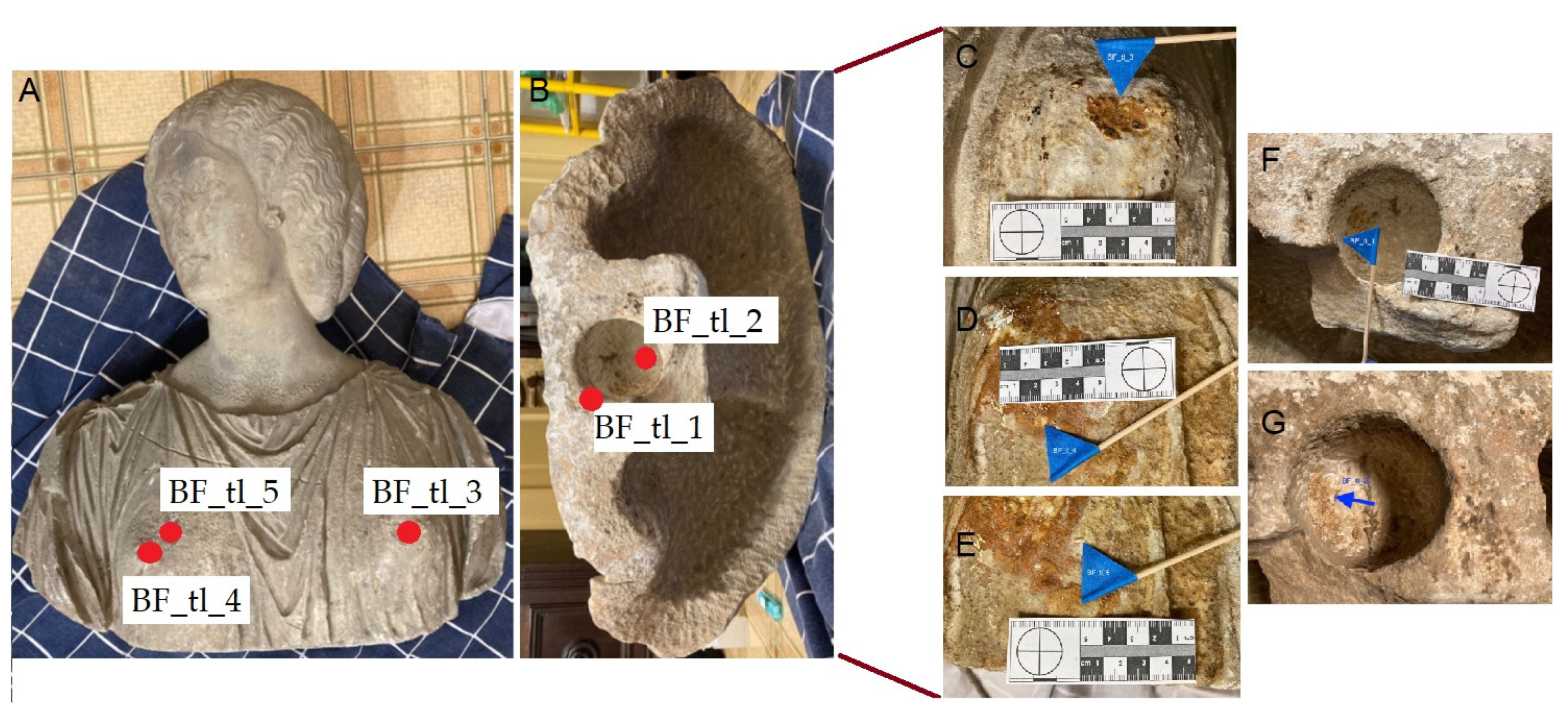
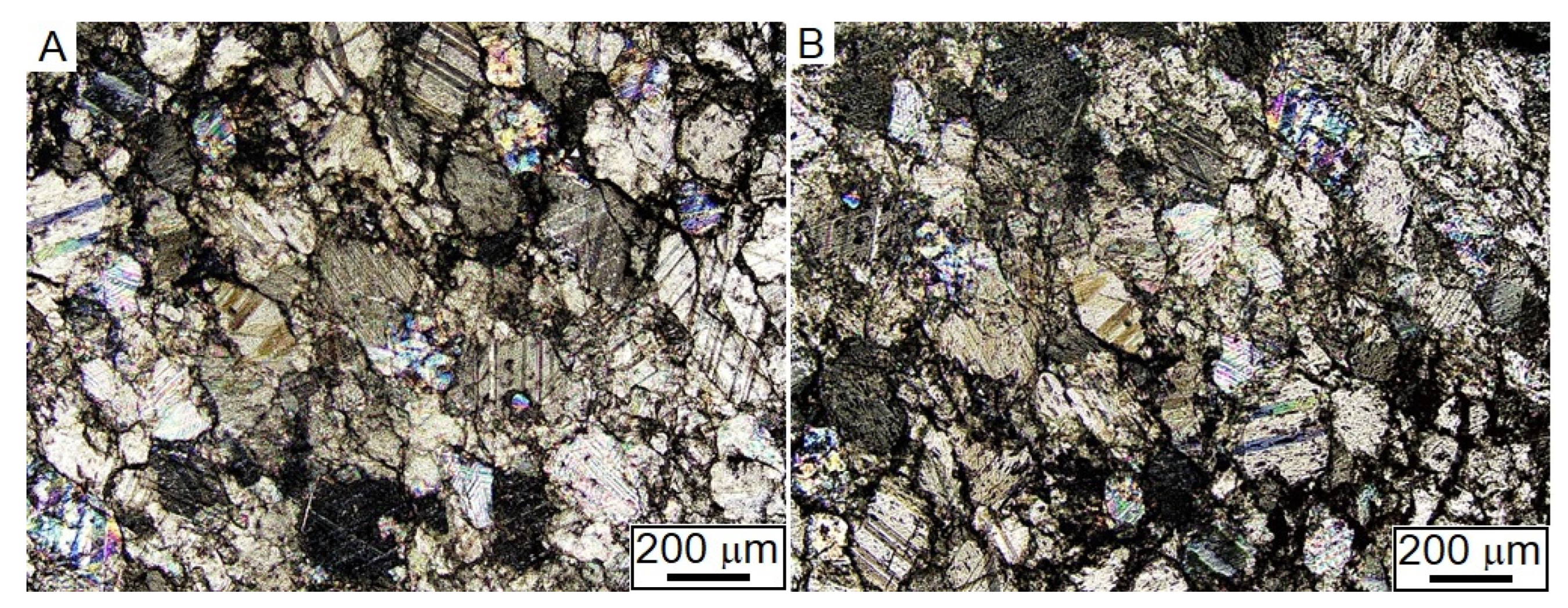
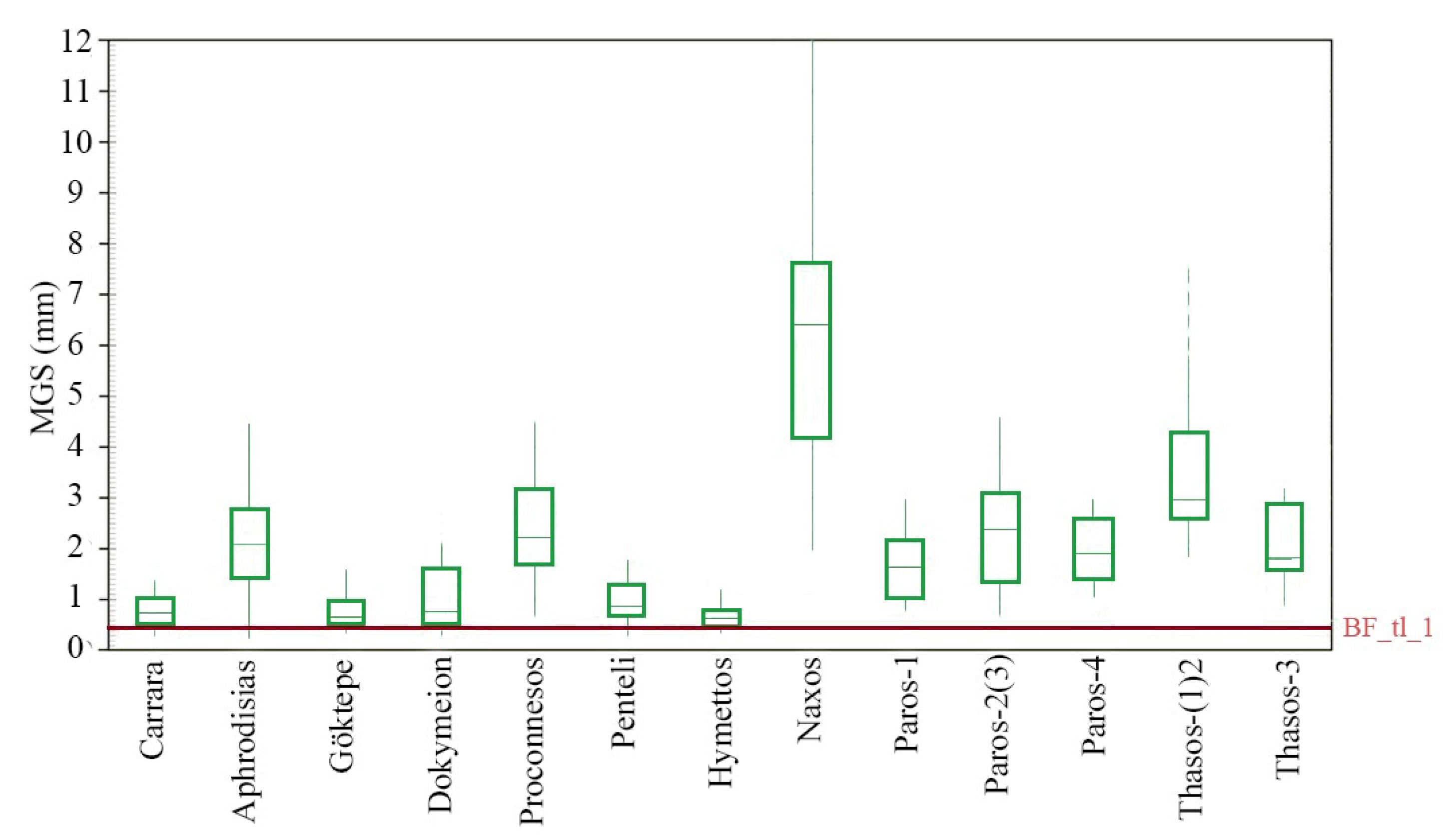
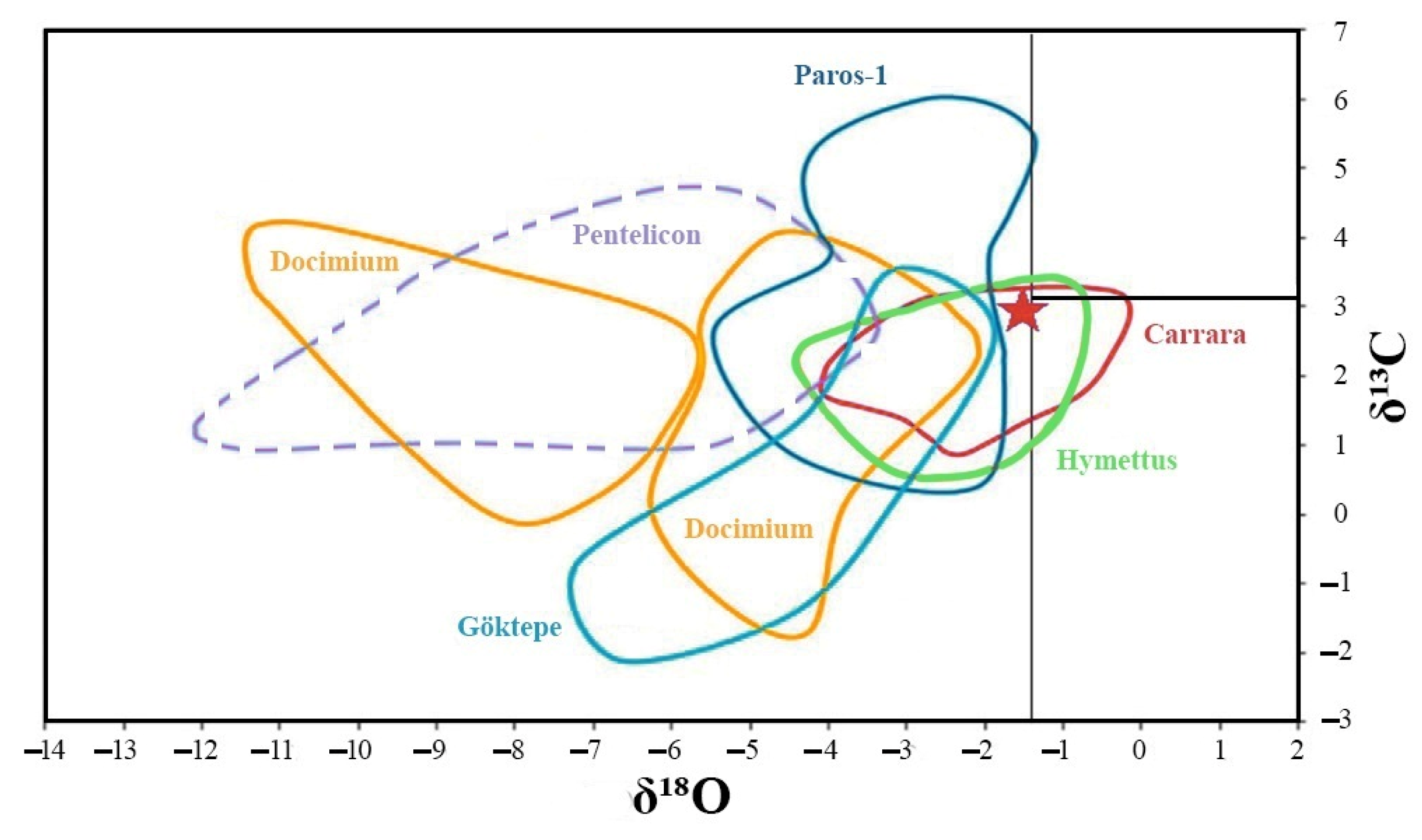
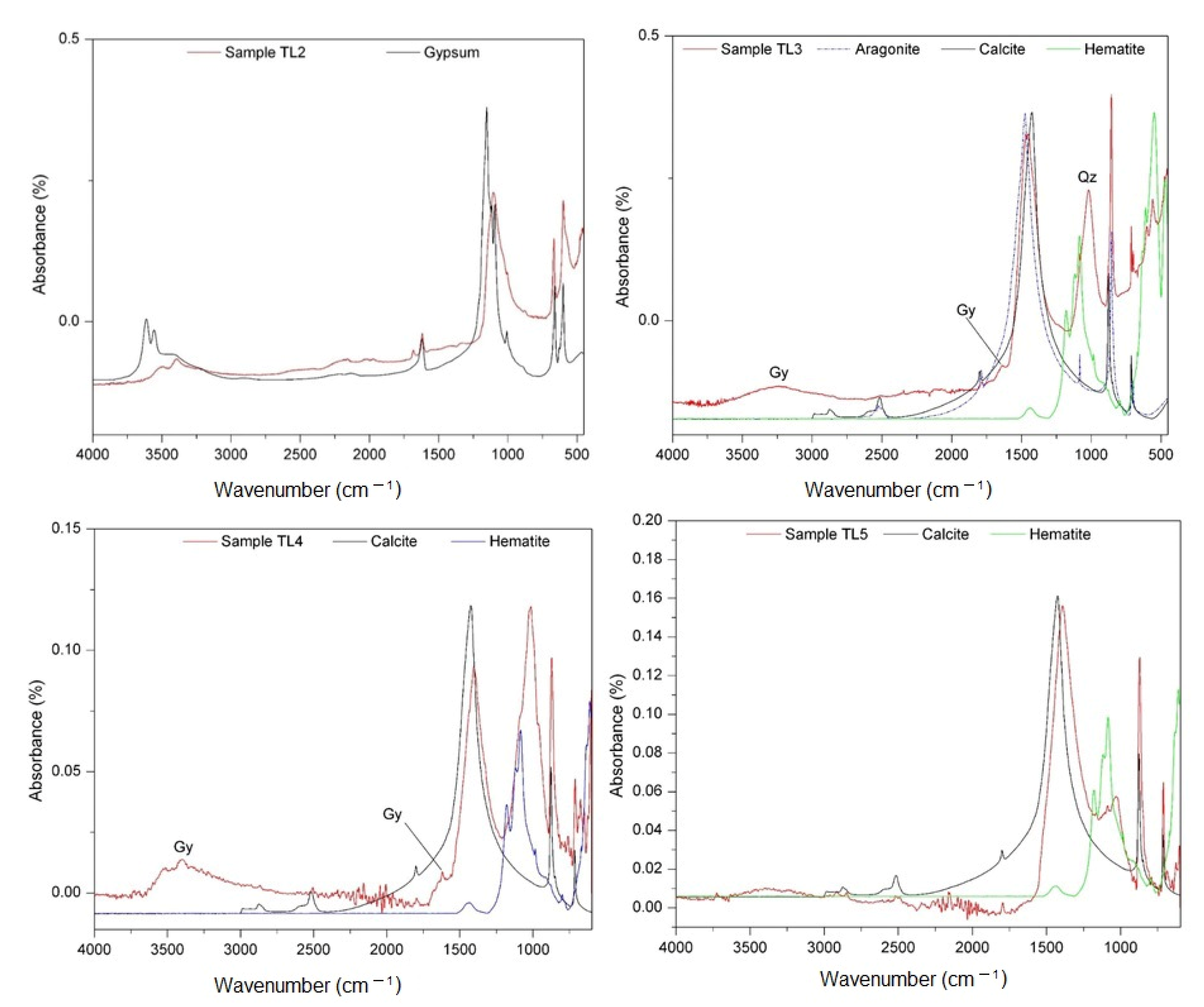

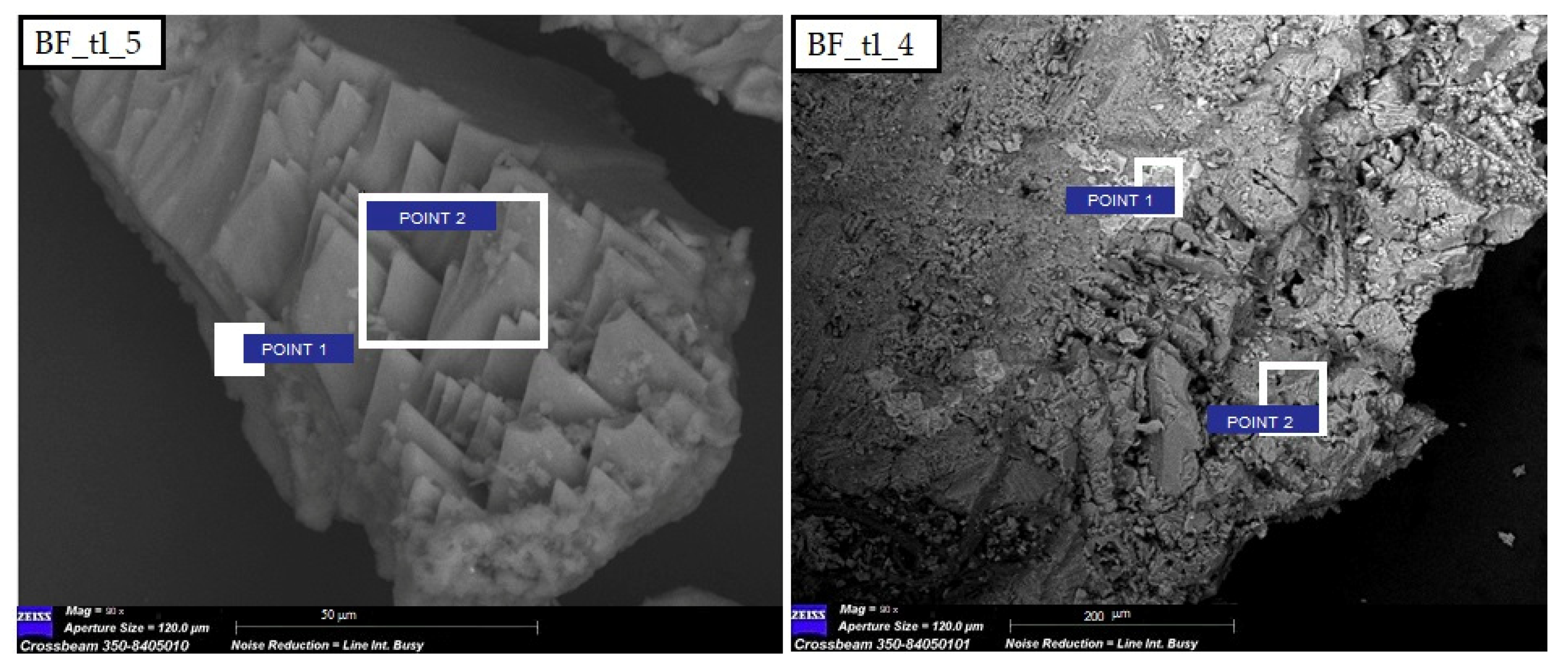
| Sample Id | Brief Description | Employed Techniques |
|---|---|---|
| BF_tl_1 | White marble microfragment from the hollow under the base of the bust | OM; XRD; δ13C and δ18O isotopes |
| BF_tl_2 | Whitish material from the hollow under the base of the bust superimposed on the constituent marble of the artifact | FT-IR |
| BF_tl_3 | Reddish material from the left breast | FT-IR; XRD |
| BF_tl_4 | Reddish material from the right breast | FT-IR; SEM-EDX |
| BF_tl_5 | Incoherent whitish material superimposed onto BF_tl_4 | FT-IR; SEM-EDX |
Disclaimer/Publisher’s Note: The statements, opinions and data contained in all publications are solely those of the individual author(s) and contributor(s) and not of MDPI and/or the editor(s). MDPI and/or the editor(s) disclaim responsibility for any injury to people or property resulting from any ideas, methods, instructions or products referred to in the content. |
© 2023 by the authors. Licensee MDPI, Basel, Switzerland. This article is an open access article distributed under the terms and conditions of the Creative Commons Attribution (CC BY) license (https://creativecommons.org/licenses/by/4.0/).
Share and Cite
Randazzo, L.; Ricca, M.; Arcudi, A.; Zicarelli, M.A.; Lia, F.; Sudano, F.; Gennaro, A.M.; La Russa, M.F. A Marble Bust Newly Discovered by the Trapani Lombardo Family of Reggio Calabria (Southern Italy). Appl. Sci. 2023, 13, 6426. https://doi.org/10.3390/app13116426
Randazzo L, Ricca M, Arcudi A, Zicarelli MA, Lia F, Sudano F, Gennaro AM, La Russa MF. A Marble Bust Newly Discovered by the Trapani Lombardo Family of Reggio Calabria (Southern Italy). Applied Sciences. 2023; 13(11):6426. https://doi.org/10.3390/app13116426
Chicago/Turabian StyleRandazzo, Luciana, Michela Ricca, Anna Arcudi, Maria Antonietta Zicarelli, Francesco Lia, Fabrizio Sudano, Andrea Maria Gennaro, and Mauro Francesco La Russa. 2023. "A Marble Bust Newly Discovered by the Trapani Lombardo Family of Reggio Calabria (Southern Italy)" Applied Sciences 13, no. 11: 6426. https://doi.org/10.3390/app13116426
APA StyleRandazzo, L., Ricca, M., Arcudi, A., Zicarelli, M. A., Lia, F., Sudano, F., Gennaro, A. M., & La Russa, M. F. (2023). A Marble Bust Newly Discovered by the Trapani Lombardo Family of Reggio Calabria (Southern Italy). Applied Sciences, 13(11), 6426. https://doi.org/10.3390/app13116426








